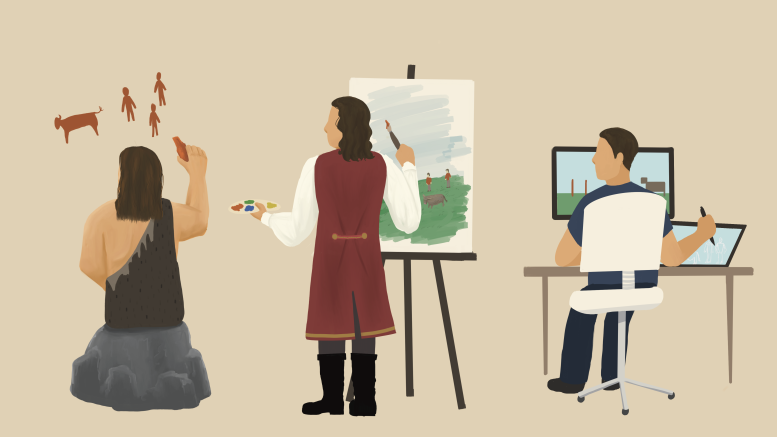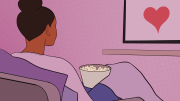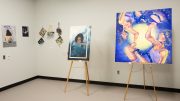My high school film teacher gave me a critical piece of advice when I asked how to compose a good scene: “The best artists steal.” He did not advise me to remake my favourite movie shot-for-shot and pass it off as my own, even though that would be interesting. What he meant was that to become a great filmmaker I need to follow in the footsteps of those who are better than me.
Art, most art anyway, by its very nature is derived from other pieces of art. For example, Pablo Picasso’s 1907 work “Les Demoiselles d’Avignon” takes clear inspiration from early Iberian sculptures. The Iberian sculpture “Head of a man” from 4th century BCE is an example of this. The deformation of the sculpture’s head, its emotionless expression and somewhat muted colour are echoed in Picasso’s piece, particularly in the faces of the women.
Furthermore, Picasso’s piece also takes inspiration from African masks. The more uniquely shaped and colourful women in “Les Demoiselles d’Avignon” look strikingly similar to the Mbuya and Dean Gle masks of the Pende and Dan peoples, respectively. One particular Mbuya mask, “Mbangu,” has a curved bisecting line that closely resembles the woman in the bottom right of Picasso’s piece.
Picasso’s piece is not reduced by the inspiration he takes from other works of art. If anything, it is enhanced by the history behind Picasso’s inspiration and the fascinating result of it.
In the world of pop culture, George Lucas’s Star Wars: Episode IV – A New Hope borrows from Akira Kurosawa’s films. Lucas was particularly inspired by Kurosawa’s 1958 film The Hidden Fortress. The opening of Star Wars closely resembles the opening of The Hidden Fortress, with C-3PO and R2-D2 being parallels to the bickering peasants in Kurosawa’s film. Not only was Star Wars’ story inspired by Kurosawa’s film, but so were its designs. Specifically, Darth Vader’s iconic helmet closely resembles the helmet, or kabuto, of a samurai.
George Lucas and Pablo Picasso are completely different artists, but the point stands. Both took strong inspiration from artists other than themselves and used that inspiration to create something great.
We all walk in the footsteps of the old masters. There is no brushstroke that hasn’t been made and no shot that hasn’t been taken.
Video games can take the derivative nature of art even further, with works such as 2023’s Dead Space being outright remakes of a previous work. While narratively and mechanically the game remains quite similar, the act of recreating a work of art is an engaging pursuit on its own, and there are enough changes to make Dead Space a worthwhile endeavour.
If you are open about inspiration and influence, then there are very few rules when it comes to artistic expression. Something I enjoy is “borrowing” other artist’s content — whether it’s music or video — remixing it, transforming it and creating something new. Parody and remix are, in my opinion, the sincerest form of homage.
When my film teacher told us to steal from better artists, he tasked us with studying those better than us, replicating what made them great and then using that practice to build something of our own. A huge part of artistic expression is finding your voice, but art does not exist in a bubble. We are constantly exposed to media and art from across the globe and throughout history.
Internalizing what we are exposed to is how we find that voice. Of course, taking someone else’s art, copying each brush stroke then passing it off as your own is immoral. I use the term “stealing” quite liberally but there is a distinct difference between borrowing an artist’s technique, style or ideas to adapt to your own vision and outright hijacking their work.
Reproducing someone else’s work without making any adaptions or changes takes little to no work whatsoever. If I take a photo of someone’s work at the Winnipeg Art Gallery, then upload it to my Instagram, that is hardly an artistic endeavour. Erasing all the effort and expression of an artist in an attempt to fake originality is an insult to the original artist and is simply unnecessary when it is so easy to admit inspiration.
However, it would be different if I took a photo of that same piece, studied it, replicated aspects of it and produced my own piece while citing it as inspiration.
One of the great things about art is that it is culture in motion, replicating and building upon itself. In a time when typing a prompt into a machine can create a hideous mockery of real art, it is important to be honest about inspirations.
When ancient humans began etching carvings into stone or putting paint onto walls, they never worried about copying the old masters too closely and neither should you, within reason of course.





